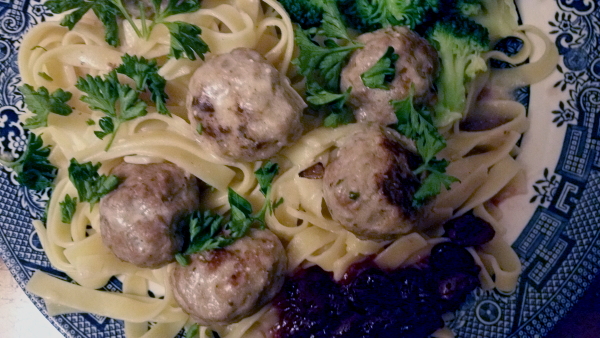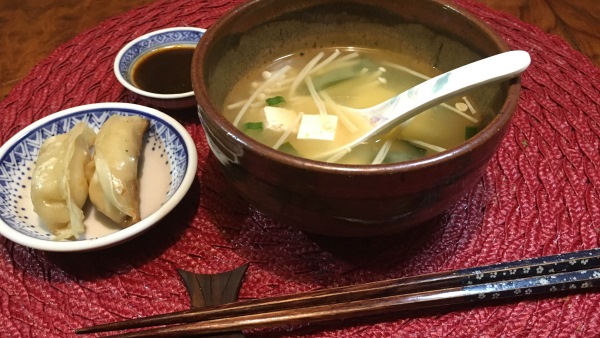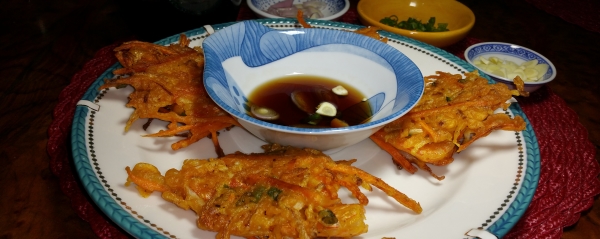
Iranian Pomegranate Soup, in Farsi (Ash Anar), is a very hearty soup suitable for a cold winter's evening meal. It has a delightful mixture of tastes that remain very distinct when eaten. Different parts of your mouth might experience very different tastes; sweet, sour and savory. This makes for an unusual, but very pleasant experience. Traditionally lamb is used for the meatballs, but beef can be substituted. Vegetarians can substitute red beets for the meat.
In most of the world, pomegranates are eaten as fruits or juiced. Pomegranates originally came from what is now Armenia and Iran. They were an extremely popular trade item on the Silk Road and were brought to the Americas with the first Europeans. In the Middle-East, pomegranate juice and pomegranate molasses are used in soups and rice dishes. One example of this use is Khoresht Fesenjan stew which is an essential part of most Iranian weddings. The stew consists mainly of ground walnuts, pomegranate molasses (or syrup), saffron, and cinnamon. Fesenjan has a rather ancient heritage. Ash Anar, the recipe for this month, is a bit more savory and contains spiced meatballs and soup greens. Pomegranate molasses can be purchased at the Balboa International Market or any other Middle-Eastern grocery. One can also purchase dried mint there.
Soups (ash) are very popular in Iran, so much so that cooks are known as ashpaz (lit. "maker of soups"). The recipe also calls for pomegranate seeds for a garnish. The trick to removing the seeds from the pomegranate fruit is to score the outer skin several times and then break open the pomegranate in a large bowl of water and nudge the seeds out with your fingers. The seeds will sink to the bottom of the bowl and the inedible white fiber will float to the top. Another method is to cut the pomegranate in half (perpendicular to the stem), place the half cut side down on the palm of your hand, whack the top with a heavy spoon, and nearly all the seeds will be dislodged into your hand. Please note that this recipe calls for browned onions (really caramelized), part of which go into the soup and part which goes into the meatballs. We use brown lentils (because we had them), but other kinds of lentils can be used if you adjust the cooking times so that the total simmering matches what is required for the lentil being used (as this varies considerably). Basmati rice is used, but other kinds can be substituted.
Ingredients:
Soup Ingredients:
- 3 tablespoons extra virgin olive oil
- 1 large or 2 medium sized onions, chopped
- 4 cloves of garlic, chopped or pressed
- 1 cup of chopped cilantro
- 1 cup of chopped parsley
- 1 cup of chopped spinach
- 2 sticks of cinnamon (or 1/2 teaspoon of powder)
- 1 teaspoon of turmeric
- 8 cups chicken or vegetable stock
- 3/4 cup of brown lentils
- 3/4 cup of Basmati rice
- 1/2 cup of pomegranate molasses
- 1 pomegranate
- 2 teaspoons of salt
- 2 teaspoons of black pepper
Meatball Ingredients:
- 1 pound ground meat (beef or lamb)
- 2 teaspoons of tarragon
- 2 teaspoons of dried rosemary
- 1 teaspoon of turmeric
- 2 whole eggs beaten
- 1 tablespoon of finely chopped parsley
Mint Sauce Ingredients:
- 3 tablespoons extra virgin olive oil
- 1/4 cupped dried crushed mint
Preparation:
- In a large pot (see picture) on medium heat, brown onions in the olive oil stirring constantly. Please note that this might take at least 10 minutes; the goal is not to burn the onions and to let them caramelize a bit.
- When the onions are close to brown, remove 3 tablespoons of the onions and put them in the bowl you will use to make the meatballs.
- Add garlic to pot and cook an additional minute or until garlic is very slightly brown, stirring constantly (garlic burns quickly).
- Clean and rinse lentils.
- Add lentils and cinnamon, turmeric, salt and pepper.
- Turn up heat and bring to a boil.
- Turn down heat and simmer soup for 30 minutes.
- Mix all the meatball ingredients and shape into walnut sized balls.
- After the soup has simmered for 30 minutes, gently stir in the pomegranate molasses, rice, meatballs, cilantro, parsley and spinach.
- Turn up heat until the soup boils and then lower heat to a simmer and cook for 20 minutes more.
- Prepare mint sauce by mixing the dried mint and oil and heating in a small pot.
- When soup is done, serve in individual bowls, drizzle a tablespoon of the mint sauce on top, and festoon with 1 tablespoon of pomegranate seeds.
- Serve with pita or other middle-eastern flat bread.
بفرماييد (befarma'id)!
Recipe by Thomas Johnston-O'Neill
Photo by Shari Johnston-O'Neill
- Details
- Hits: 3515

Swedish Meatballs (Svenska Köttbullar are a perfect dish to enjoy during the cold and rain-drenched days of normally sunny San Diego. The meatballs should be light and slightly springy in texture.
The tradition of eating meatballs in Sweden can be traced to the 1700's. Recipes for "Köttbullar" can be found in cook books from 1800's, and each family develops their own variations on the dish.
The Swedes are worldwide known for their meatballs but can't take credit for the invention. It is believed that King Karl XII, who reigned during the late 1700's‚ brought the dish back from one of his journeys in Turkey. The Turkish meatballs can be found in many different variations, but it may be that the original meatballs came from Persia.
Almost everyone that has visited IKEA has at least once tried the meatballs with potato‚ brown sauce and lingonberry jam, judging from the fact that they are the number one food that is bought at IKEA. Now they even sell vegan meatballs. However, if you make them yourself, you will find that they will taste even better!
Ingredients:
- 4 slices fresh white bread
- 1/4 cup milk
- 3 tablespoons butter
- 1 medium onion finely chopped onion
- 1 pound ground beef
- 1 pound ground pork
- 2 egg yolks
- 1/2 teaspoon black pepper
- 1/4 teaspoon ground allspice
- 1/4 teaspoon freshly grated nutmeg
- 1 teaspoon kosher salt
- 1/4 cup all-purpose flour
- 3 cups beef broth
- 1/4 cup light olive oil
- 1/2 cup heavy cream
- Several parsley sprigs chopped (for garnish)
Preparation:
- Sauté onions in butter until they turn translucent.
- Break up the bread into small piece and add to mixing bowl with milk and eggs.
- Add ground pork, ground beef, onions, pepper, allspice, nutmeg and salt to the mixing bowl and mix thoroughly (if using a Kitchen-Aid type mixer it will be a lot easier).
- Pre-heat oven to 350 degrees
- Using a kitchen scale, make meatballs by rolling in your palms one ounce of the mixture, arranging the meatballs on a cooking sheet
- Cook for 25 minutes
- Turn oven down to 200 degrees.
- Heat olive oil in large skillet to medium high.
- Working in batches, brown the meatballs slightly.
- Return the meatballs to the oven to keep them warm.
- Turn skillet down to medium.
- Add flour to pan and mixing it well with the leftover pan drippings.
- brown the roux (flour and drippings)until it turns a light brown.
- A little at a time, whisk in the beef broth breaking up any clumps.
- While whisking, gently bring to a boil.
- Whisk in the heavy cream.
- Stirring frequently, cook the gravy for about 5 more minutes.
- Put the meatballs in a serving bowl and cover with gravy.
- Serve with a small dish of Lingonberry jam. (Available at IKEA!)
Additional notes: These are great for parties, as the meatballs are easy to pick up with toothpicks. Swedish meatballs are often served with boiled or mashed potatoes. Our favorite way to serve them, however, is over German egg noodles with a green vegetable or salad.
Intro by Josefin Hultén
Recipe by T. Johnston-O'Neill
Photo by Shari Johnston-O'Neill
- Details
- Hits: 3809

Japanese Misoshiru is a savory but delicate soup that is an essential part of Japanese dining.
According to The Book of Tofu & Miso, 75% of Japanese eat miso soup every single day. Miso<<shiru (味噌汁) can be purchased pre-mixed in a packet or you can make it from scratch (We will show you how!). In Japan you can purchase freeze-dried miso soup that re-hydrates when boiling water is added; the resulting taste and texture is remarkably good. Although it is simple to make, the techniques for creating some of the basic ingredients require a great deal of technique, effort and time.
The soup base, known as dashi (出汁), is flavored with miso paste, bonito (skip jack tuna) flakes and konbu (昆布) seaweed. Not only is it a key ingredient in miso soup but it is found in an enormous number of other Japanese soups and foods. The base used for miso soup is called "konbu katsuo dashi" after its two main ingredients, konbu and katsuobushi which I will discuss below. Growing up in America, people learn there are four basic tastes; sweet, sour, bitter and salty. However, in 1908 Japanese chemist Kikunae Ikeda suggested there was a fifth taste which he called umami (meaning "pleasant savory taste"). Further scientific research backed this claim with the discovery of taste receptors specific to glutamate. Ikeda originally studied the konbu seaweed, but discovered that glutamate was found in a wide variety of foods including tomatoes, wheat, shell fish. soy, meats, and more. Ikeda also extracted glutamates from konbu and called his "flavor enhancer" "Aji no Moto" which we know as monosodium glutamate or MSG. Many Chinese dishes also use MSG, and while many non-Asian people claim to have bad reactions to it (headaches, flushing, weakness, etc.) and while the Mayo Clinic website claims "Researchers have found no definitive evidence of a link between MSG and these symptoms." Much like gluten, many food packages and restaurant menus proudly proclaim "No MSG". We will leave it up to the readers whether these adverse claims are warranted or simply marketing ploys directed towards the overly cautious.
Most people who make their own miso soup use dashi powder which is a ground mixture of bonito, some seaweed and often aji no moto (MSG). The addition of MSG to dashi power simply adds more umami flavor to the dashi, and is not used when making dashi from scratch. Adding extra MSG to dashi might be a case of gilding the lily.
Miso is fermented soybean paste, however it typically has other ingredients, most notably rice and barley. "White miso" (shiro miso, 白味噌) is lightest in color and mildest in taste, having more rice and a shorter fermentation than "red" (Aka, 赤味噌) miso. Due to its pleasing color and delicate taste, shiro miso is preferred for miso soup, but some recipes (particularly English-language recipes) call for the stronger tasting variety. Miso has a great variety of uses, but by far its most popular use is for miso soup.
While making miso requires little preparation on the part of the cook, the creation of the bonito flakes flakes, or katsuobushi (鰹節), is a long, involved interesting process. Fortunately all this is done for you, you just need to open the bag and use the amount required! Traditionally a skip jack tuna is beheaded, gutted, filleted and trimmed of fat. The fish is boiled for more than an hour and then the bones are removed. The fish is then smoked very slowly for 5 to 6 hours, then the fish is left to cool and rest for a day. This process is repeated for the same fish more than a dozen times, the total time being up to a month. The filets are then sprayed with Aspergillus glaucus mold culture and left in a cave (most traditionally) or in a cold room. This process draws all the moisture out of the fish and greatly concentrates their flavor. The mold is then scraped off and the process is repeated two to three times. The number of times this process is repeated determines the type of katsuobushi. If it is done three times it is called honkarebushi (本枯節) (true dried fillet). The most expensive katsuobushi is dried using this process for as long as two years. The result is a fish that has the same hardness as a very hard wood. Traditionally the fish is shaved with a Katsuobushi kezuriki (鰹節削り器), a wooden box fitted with a razor sharp blade. The shavings are pink in color, extremely thin and translucent. Katsuobushi is often added to other Japanese dishes and when they are sprinkled on top of hot dishes, such as soups, the rising steam makes the much-thinner-than-paper flakes "dance". It is a sight to behold and enjoy. However, if you add katsuobushi to your dishes, be careful because a little goes a very long way. Don't overdo it!
In addition to the bonita flavoring and the miso, a large piece of seaweed known as konbu is added to the stock. It comes in large leaves, you must cut it to fit in the pot. Good konbu has a whitish powder on it's surface. At least one Internet video suggests wiping this power off with a wet towel. That recommendation is suspect, the white powder actually is important to the depth of the taste. Most konbu is harvested in the cold ocean waters of Japan's northernmost island, Hokkaido. The home of katsuobushi is in the southeastern region of the main island of Honshu and there has been a vital trade route from Hokkaido to the south since the early 17th century.
Miso soup can contain many different ingredients, however, tofu, wakame (ワカメ) dried seaweed and Japanese enokitake (榎茸) or "enoki" mushrooms are, by far, the most popular. Tofu comes in soft, medium and firm styles. Perhaps soft tofu is the most traditional for miso soup, but this is really up to the preference of the cook. Wakame dried seaweed is true magic. Before it is added to the soup it is in the form of very small dried bits. A minute after it is in the soup it becomes a silky marvel that tastes great and has a very nice texture. When I didn't have any wakame, I've tried making the soup with spinach, and indeed some English language recipes suggest this. However, unless you have a miso soup emergency (Heaven forbid!), resist this idea as the results will pale in comparison to the real stuff.
The last ingredient is enoki mushrooms, which are sold in a bunch. Their stems are long and thin and their heads are small as a green pea. They have a delicate taste and texture. Other mushrooms can be substituted, but results may be less desirable.
Japanese cuisine is based on an esthetic that appreciates not only the taste of a dish but its presentation and texture. Good miso soup looks, tastes and feels like a work of culinary art when done properly.
All the ingredients for this soup can be purchased at Mitsuwa Market or any other Japanese food market.
Ingredients:
- 5 cups of water
- 1 ounce of konbu seaweed
- 1/2 ounce of katsuobushi bonita flakes
- 3 tablespoons wakame seaweed
- 6 level tablespoons shiro miso (white miso)
- 1/3 of a package of enoki mushrooms
- 6 ounces of tofu (half a standard package)
Cook's note: Unfortunately, most of the ingredients for this recipe are sold in amounts that are much more than needed for this recipe which serves 6. The konbu, katsuobushi, wakame and the miso keep very well, but the mushrooms and tofu should be used within a week's time to avoid spoilage. Usually (not always) tofu is packed in water and must be refrigerated after the package is open. Tofu will last considerably longer if you store it in water and change the water daily. Please note that this recipe generally has more solid ingredients (wakame, enoki and tofu) than might be typical for traditional miso soup which is generally more brothy.
Preparation:
Cook's note: Temperature and time are very important to this recipe, miso soup should not be boiled.
- Cut the tofu into 1/2 inch square cubes
- Cut the enoki mushrooms in half (to the point where the individual stalks separate).
- Add 5 cups of water to a pot and heat to the point that it is very hot to touch, but not hotter (about 110 degrees Fahrenheit).
- Add the konbu seaweed and seep for 30 minutes. (Make sure the water doesn't get too hot).
- Remove the konbu and save for a different Japanese dish or discard it
- Heat the broth almost to boiling level (but not boiling) and add the katsuobushi.
- After one minute, strain the broth with a cloth-lined (cheesecloth works fine) strainer into a bowl. Do not squeeze!
- Heat the broth to almost a boil
- Add the tofu, wakame seaweed and enoki mushrooms
- Heat for a minute and a half (again, don't boil)
- Serve in small bowls and garnish with a few small rings of scallions (green onion).
Itadakimasu! (a humble expression of gratitude, used before dining but also used in other contexts such as receiving a gift from an older person or an award).
Recipe and text by T. Johnston-O'Neill
Photo by Emily Johnston-O'Neill
- Details
- Hits: 3848
Our Recipe of the Month is for French Tarte Tatin, caramelized "upside-down" pie typically made with apples. It's origin and the best way to prepare it are in dispute; what is not contested, however, how absolutely delicious it is!
- Details
- Hits: 8957

Most English language sources for this recipe call for a batter made from cornstarch, although rice flour might be more authentic and is available in Asian markets here. The shrimp should be small, this is not a time to be using jumbo prawns! Some recipes also call for using dried shrimp (shell on) for a greater concentration of flavor. If you decide to shell the shrimp, put the water from this recipe on the stove, add the shrimp shells, boil for 2 minutes, and then strain the liquid. Let the liquid cook, and then use it for the batter. Another great use for the shrimp shells is to heat them gently in butter, and then strain and cool the butter which can be used with any dish you might want to add a shrimp taste to. De-veining the shrimp is up to your discretion. Some ukoy are made with head and tail shrimp that sit on top of the fritter, and in some the battered fritter is place on top of a small square of banana leaf and then lowered into the frying oil.
Sawsawan is the Filipino term for a variety of sauces, and such sauces are a important distinguishing feature of Filipino food.There are many varieties of sawsawan that go with many different dishes. Filipino professor, publisher, and food columnist Doreen Gamboa Fernandez has written that sawsawan is one of the ways in which Filipinos "indigenize" foreign foods that have become part of their cuisine: that is, taking an unfamiliar or new food and adjusting the taste to Filipino palates. She goes on to say that the relationship between the chef and the diner is not dominating. Instead the diner mixes their sawsawan to their own particular preference with the full assent of the chef who recognizes the diner as an active participant in the culinary process. So one way of serving ukoy is to provide all the ingredients for the sawsawan and let each diner mix their own right at the table! Fernandez's research and writings were less concerned with the question of "authenticity" in Filipino foods than "how dishes became Filipino," a scholarly acknowledgement of the syncretism of culinary culture and a process found throughout the world.1
Ukoy is a popular street and party food in the Philippines, but it has made its way to restaurant menus as well. It is thought to have originated in Laguna, which is in the southeast part of Luzon. This area is also famous for their coconut cream pie called "Buko pie". There is considerable variation in the ingredients used in Ukoy, although essential ingredients are shrimp and mung bean sprouts. Some recipes call for adding small cubes or strips of tofu; others use carrots, squash, cabbage or even green papaya.
The anatto powder, from the "lipstick tree" bixa orellana, is used mostly to give the fritter a brighter reddish color. Anatto (or Achote) is used in many Latino dishes and was traditionally also used as a dye for fabrics and for lipstick. I would imagine that paprika would be a reasonable substitute, but there are many markets in San Diego where anatto may be found.
Ingredients:
- 1 cup small to medium raw shrimp washed and de-veined but with shell left on*
- 1 cup mung bean sprouts
- 1 cup sweet potato cult into thin sticks (julienned)
- 1 medium onion sliced thin
- 2 scallions finely chopped
- 1 cup rice flour or cornstarch
- 1/2 cup all purpose flour
- ½ teaspoon baking powder
- 1 teaspoon anatto powder (also called achiote)
- 1 egg
- ½ teaspoon salt
- ½ teaspoon ground black pepper
- 1 ¼ cups water
Sawsawan:
- 4 cloves garlic, minced
- 1-2 shallots sliced thin
- 2 tablespoon sugar
- ¾ cup white vinegar
- ¼ cup water
- 3 tablespoon soy sauce
- 3 small hot peppers sliced small
* It is best to use small shrimp in their shells. Sacrificing a bit of taste you can make this with peeled shrimp.
Preparation:
- De-vein the shrimp, using the following method: Make a small 1/3" longitudinal cut in the shell along the back from the big end. With a toothpick, gently fish out the black vein clamping the vein between your thumb and the toothpick. Gently pull the vein out in a straight motion.
- Place dry ingredients (cornstarch, flour, baking powder, anatto powder, salt pepper) in a mixing bowl; add egg and water and whisk into a smooth batter.
- Fold the shrimp, bean sprouts, sweet potatoes, scallions and onion into the batter, mixing thoroughly to coat all the ingredients.
- Fill a deep frying pan or pot with about 1 inch of cooking oil. Heat oil to 350 to 375 degrees.
- With a large metal cooking spoon, scoop up about 3 tablespoons of the battered mixture and lower it into the hot oil.
- Cook on one side for about 3 minutes; then with metal tongs or the metal spoon, gently flip over the fritter and fry for another 2 minutes. Work in small batches; do not overcrowd the pan. When finished, the Ukoy should be golden-brown.
- Remove the Ukoy when it is golden brown and place on either a metal rack (preferred) or paper towels.
- Prepare the vinegar dipping sauce by mixing all the sauce ingredients together and then pour the sauce into individual small bowls, one per diner.
Serve as a snack or with rice and a vegetable dish as a main course.
Tayo'y magsikain, Kainan na!
Recipe by T. Johnston-O'Neill
Photo by Shari Johnston-O'Neill
1 Culture Ingested: On the Indigenization of Philippine Food by Barbara Kirshenblatt-Gimblett.
- Details
- Hits: 4249
Joomla!
Extensions
The Joomla! content management system lets you create webpages of various types using extensions. There are 5 basic types of extensions: components, modules, templates, languages, and plugins. Your website includes the extensions you need to create a basic website in English, but thousands of additional extensions of all types are available. The Joomla! Extensions Directory is the largest directory of Joomla extensions.
Components
Components are larger extensions that produce the major content for your site. Each component has one or more "views" that control how content is displayed. In the Joomla administrator there are additional extensions such as Menus, Redirection, and the extension managers.
Modules
Modules are small blocks of content that can be displayed in positions on a web page. The menus on this site are displayed in modules. The core of Joomla! includes 24 separate modules ranging from login to search to random images. Each module has a name that starts mod_ but when it displays it has a title. In the descriptions in this section, the titles are the same as the names.
Content Modules
Content modules display article and other information from the content component.
User Modules
User modules interact with the user system, allowing users to login, show who is logged-in, and showing the most recently registered users.
Display Modules
These modules display information from components other than content and user. These include weblinks, news feeds and the media manager.
Utility Modules
Utility modules provide useful functionality such as search, syndication and statistics.
Navigation Modules
Navigation modules help your visitors move through your site and find what they need.
Menus provide your site with structure and help your visitors navigate your site. Although they are all based on the same menu module, the variety of ways menus are used in the sample data show how flexible this module is.
A menu can range from extremely simple (for example the top menu or the menu for the Australian Parks sample site) to extremely complex (for example the About Joomla! menu with its many levels). They can also be used for other types of presentation such as the site map linked from the "This Site" menu.
Breadcrumbs provide users with information about where they are in a site.
Page 25 of 29








